Yi Chao likes to describe himself as an “armchair oceanographer” because he got incredibly seasick the one time he spent a week aboard a ship. So it’s maybe not surprising that the former NASA scientist has a vision for promoting remote study of the ocean on a grand scale by enabling underwater drones to recharge on the go using his company’s energy-harvesting technology.
Many of the robotic gliders and floating sensor stations currently monitoring the world’s oceans are effectively treated as disposable devices because the research community has a limited number of both ships and funding to retrieve drones after they’ve accomplished their mission of beaming data back home. That’s not only a waste of money, but may also contribute to a growing assortment of abandoned lithium-ion batteries polluting the ocean with their leaking toxic materials—a decidedly unsustainable approach to studying the secrets of the underwater world.
“Our goal is to deploy our energy harvesting system to use renewable energy to power those robots,” says Chao, president and CEO of the startup Seatrec. “We're going to save one battery at a time, so hopefully we're going to not to dispose more toxic batteries in the ocean.”
Chao’s California-based startup claims that its SL1 Thermal Energy Harvesting System can already help save researchers money equivalent to an order of magnitude reduction in the cost of using robotic probes for oceanographic data collection. The startup is working on adapting its system to work with autonomous underwater gliders. And it has partnered with defense giant Northrop Grumman to develop an underwater recharging station for oceangoing drones that incorporates Northrop Grumman’s self-insulating electrical connector capable of operating while the powered electrical contacts are submerged.
Seatrec’s energy-harvesting system works by taking advantage of how certain substances transition from solid-to-liquid phase and liquid-to-gas phase when they heat up. The company’s technology harnesses the pressure changes that result from such phase changes in order to generate electricity.

To make the phase changes happen, Seatrec’s solution taps the temperature differences between warmer water at the ocean surface and colder water at the ocean depths. Even a relatively simple robotic probe can generate additional electricity by changing its buoyancy to either float at the surface or sink down into the colder depths.
By attaching an external energy-harvesting module, Seatrec has already begun transforming robotic probes into assets that can be recharged and reused more affordably than sending out a ship each time to retrieve the probes. This renewable energy approach could keep such drones going almost indefinitely barring electrical or mechanical failures. “We just attach the backpack to the robots, we give them a cable providing power, and they go into the ocean,” Chao explains.
The early buyers of Seatrec’s products are primarily academic researchers who use underwater drones to collect oceanographic data. But the startup has also attracted military and government interest. It has already received small business innovation research contracts from both the U.S. Office of Naval Research and National Oceanic and Atmospheric Administration (NOAA).
Seatrec has also won two $10,000 prizes under the Powering the Blue Economy: Ocean Observing Prize administered by the U.S. Department of Energy and NOAA. The prizes awarded during the DISCOVER Competition phase back in March 2020 included one prize split with Northrop Grumman for the joint Mission Unlimited UUV Station concept. The startup and defense giant are currently looking for a robotics company to partner with for the DEVELOP Competition phase of the Ocean Observing Prize that will offer a total of $3 million in prizes.
In the long run, Seatrec hopes its energy-harvesting technology can support commercial ventures such as the aquaculture industry that operates vast underwater farms. The technology could also support underwater drones carrying out seabed surveys that pave the way for deep sea mining ventures, although those are not without controversy because of their projected environmental impacts.
Among all the possible applications Chao seems especially enthusiastic about the prospect of Seatrec’s renewable power technology enabling underwater drones and floaters to collect oceanographic data for much longer periods of time. He spent the better part of two decades working at the NASA Jet Propulsion Laboratory in Pasadena, Calif., where he helped develop a satellite designed for monitoring the Earth’s oceans. But he and the JPL engineering team that developed Seatrec’s core technology believe that swarms of underwater drones can provide a continuous monitoring network to truly begin understanding the oceans in depth.
The COVID-19 pandemic has slowed production and delivery of Seatrec’s products somewhat given local shutdowns and supply chain disruptions. Still, the startup has been able to continue operating in part because it’s considered to be a defense contractor that is operating an essential manufacturing facility. Seatrec’s engineers and other staff members are working in shifts to practice social distancing.
“Rather than building one or two for the government, we want to scale up to build thousands, hundreds of thousands, hopefully millions, so we can improve our understanding and provide that data to the community,” Chao says.
Jeremy Hsu has been working as a science and technology journalist in New York City since 2008. He has written on subjects as diverse as supercomputing and wearable electronics for IEEE Spectrum. When he’s not trying to wrap his head around the latest quantum computing news for Spectrum, he also contributes to a variety of publications such as Scientific American, Discover, Popular Science, and others. He is a graduate of New York University’s Science, Health & Environmental Reporting Program.



